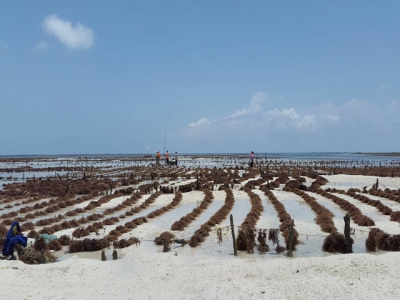Low trophic aquaculture given high research priority

A new international research and industry enterprise has been formed to accelerate the development, education and communication of sustainable low-trophic aquaculture in the nations bordering the Atlantic.
The project aims to enhance the production of low trophic level species, such as seaweed, along the Atlantic coast
The 36-partner, AquaVitae Consortium, has been allocated €8 million from the EU’s Horizon 2020 programme. Over the next four years, the partners will work to increase aquaculture production of low-trophic species in 16 different countries, spread across four continents.
The project’s purpose is to introduce new low-trophic species, products and processes in marine aquaculture value chains across the Atlantic. The five chosen value chains include macroalgae, integrated multi-trophic aquaculture (IMTA), echinoderm species (such as sea urchins), shellfish and finfish. IMTA is a process that farms several species together using waste from one species as feed for another.
The University of New England (UNE) School of Marine Programs and UNE North (the Institute for North Atlantic Studies) will play key roles in developing training and education pathways to support the region’s growing aquaculture ecosystems. UNE is partnering with Nofima - the Norwegian Institute of Food, Fisheries and Aquaculture Research - to fund travel to partner institutions, collaborate in research and develop best practices.
“It’s a tremendous honour to be the only US institution in the consortium,” says Barry Costa-Pierce, executive director of UNE North. “For UNE faculty and students, AquaVitae provides information and interactions with 35 consortium partners in higher education, national research institutes and industries involved in a wide range of aquaculture disciplines such as hatchery production, processing, resource management, economics, environmental monitoring, product development, marketing and consumer behaviour.”
According to Maine’s Department of Marine Resources, there were 672 aquaculture leases covering nearly 800 acres along the coast in 2018 with a total harvest value of $71.75 million. “In addition, new land-based RAS systems for salmon have been proposed with total investments exceeding $500 million,” says Costa-Pierce.
This correlates with recommendations made in the Food from the Oceans report (2017), which highlighted the need to expand low- and multi-trophic marine aquaculture as an ecologically efficient source of increasing food and feed.
Cross-cutting activities
To complete the objectives, 11 case studies will be conducted across the Atlantic, with emphasis on developing new products from low-trophic species (eg macroalgae and sea urchins), optimising production in existing industries (eg shellfish and finfish) and moving towards zero waste and a circular economy in aquaculture (eg IMTA and biofloc).
Some of the cross-cutting activities involve research into biosensors, Internet of Things (IoT), product characteristics, market potential, sustainability, environmental monitoring, as well as conducting risk assessments, analyses of value chains, studying profitability and the legal framework.
Furthermore, the project will implement a multi-actor approach to ensure stakeholder involvement in all phases of the project. Companies act as partners of the consortium together with research institutes and universities, which will also help to establish a durable aquaculture industry and research network around the Atlantic Ocean.
Related news
 Tra Vinh applies advanced technology in super-intensive shrimp farming
Tra Vinh applies advanced technology in super-intensive shrimp farming Tra Vinh is running a high-tech project to boost the capacity of the local super-intensive farming model for white-leg shrimps.
 Pangasius prices plunge with export challenges
Pangasius prices plunge with export challenges Since the beginning of the year, exports of pangasius have faced many difficulties. This gloomy situation immediately pulled the price of domestic catfish down
 Seafood exports of the first six months increase 0.6% year on year
Seafood exports of the first six months increase 0.6% year on year Total seafood production outcomes and export volume in the first six months met the plan and exceed what was achieved in the same period of 2018